Low-Frequency Rotation of Surface Winds over Canada
Abstract
:1. Introduction
2. Methods
2.1. Datasets and Data Quality
2.2. Reconstruction of a Continuous Record of Wind Direction Drift
2.3. Temporal Analysis of Point Surface Winds: SWR Drift
2.4. Zonal and Meridional Analysis of SWR

3. Results
3.1. Basic Asymmetry: Net Rotation of Surface Winds
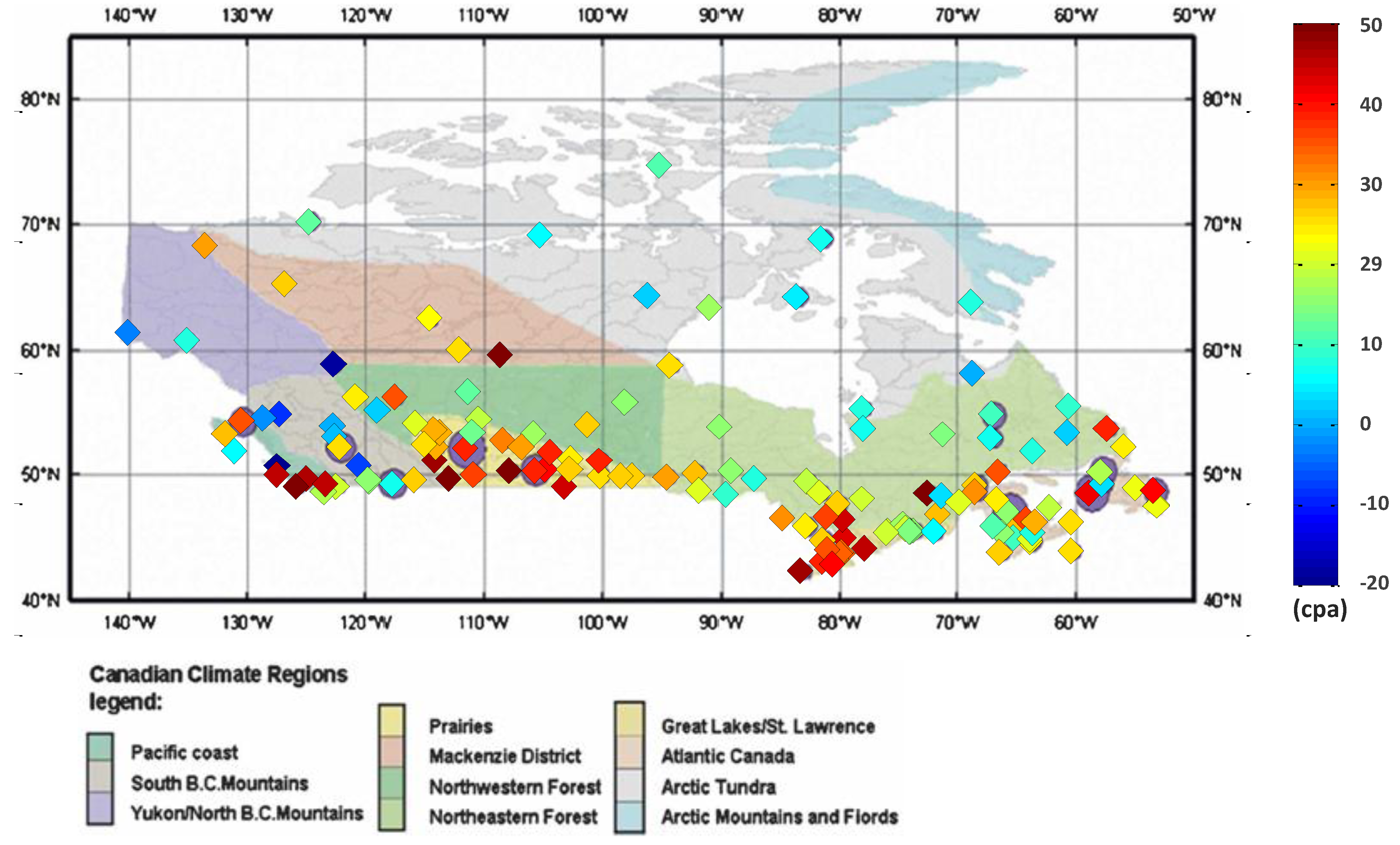
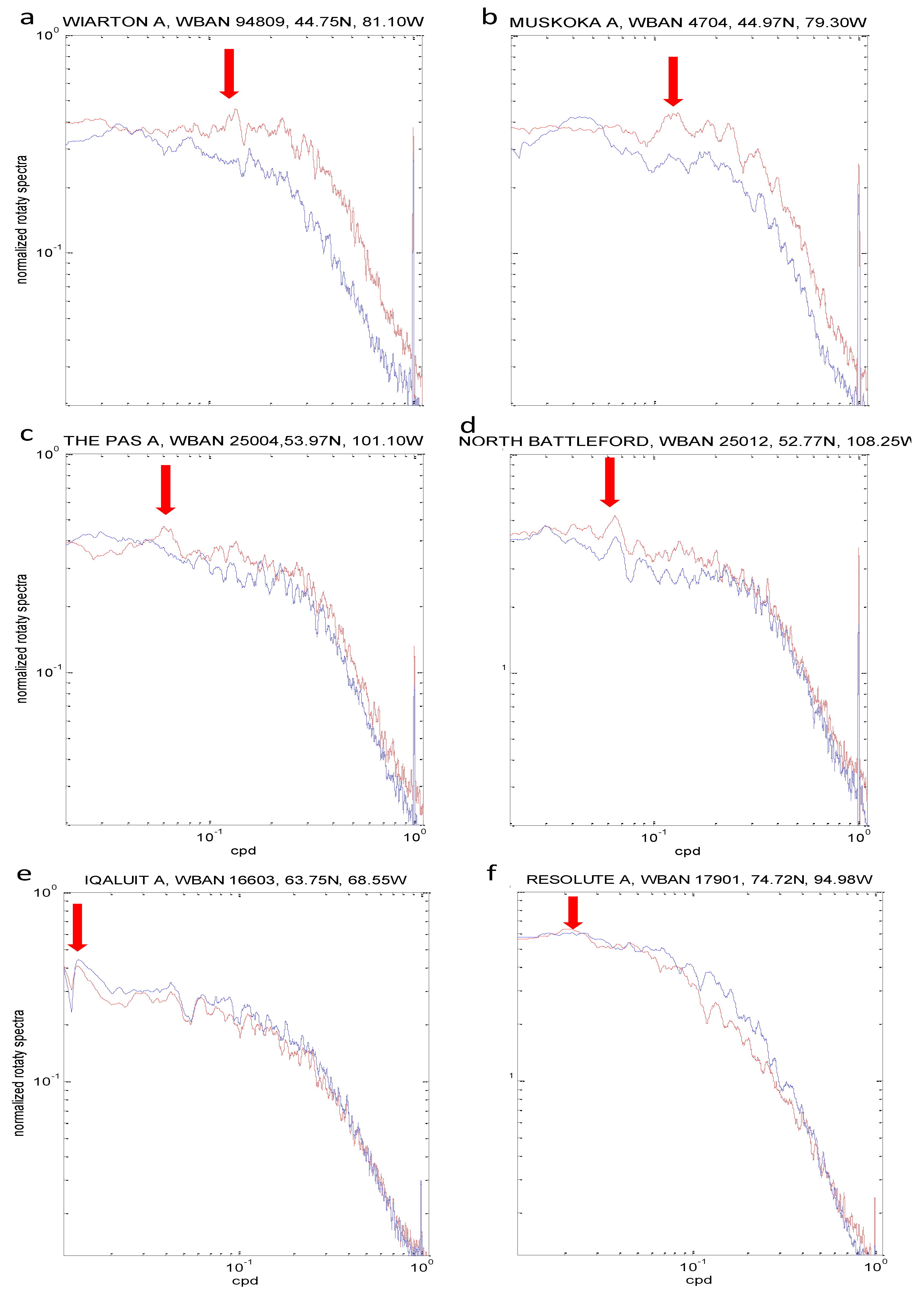
3.2. Stationarity of SWR on a Decadal Scale
| Transect Width | Province a | n | α max | R2 | α Κ | τ Κ |
|---|---|---|---|---|---|---|
| 52.8W–59.9W | NFL | 9 | 0.05 | 0.97 | - | - |
| 60.0W–69.9W | NFL,NB,NS,PEI,QC,NWT | 25 | 0.01 | 0.98 | 0.1 | 0.26 |
| 70.9W–79.9W | QC, SE-ON | 26 | 0.1 | 0.81 | 0.05 | 0.33 |
| 80.0W–89.9W | NW-ON, NU | 16 | 0.1 | 0.9 | 0.01 | 0.72 |
| 90.0W–99.9W | NW-ON, MAN, NU | 10 | 0.01 | 0.99 | 0.05 | 0.57 |
| 100.0W–109.9W | MAN, SASK, NU, NWT | 15 | 0.05 | 0.96 | 0.1 | 0.33 |
| 110.0W–119.9W | ALTA, NU, NWT | 16 | 0.01 | 0.99 | 0.01 | 0.54 |
| 120.0W–129.9W | BC, YU, NWT | 18 | 0.01 | 0.89 | - | - |
| 130.0W–140.0W | YU, NWT | 6 | 0.05 | 0.96 | - | - |
| Outliers b | BC (4), QC (2), YU (2) | 8 | 0.01 | 0.94 | - | - |
3.3. Zonal and Meridional Structure of SWR
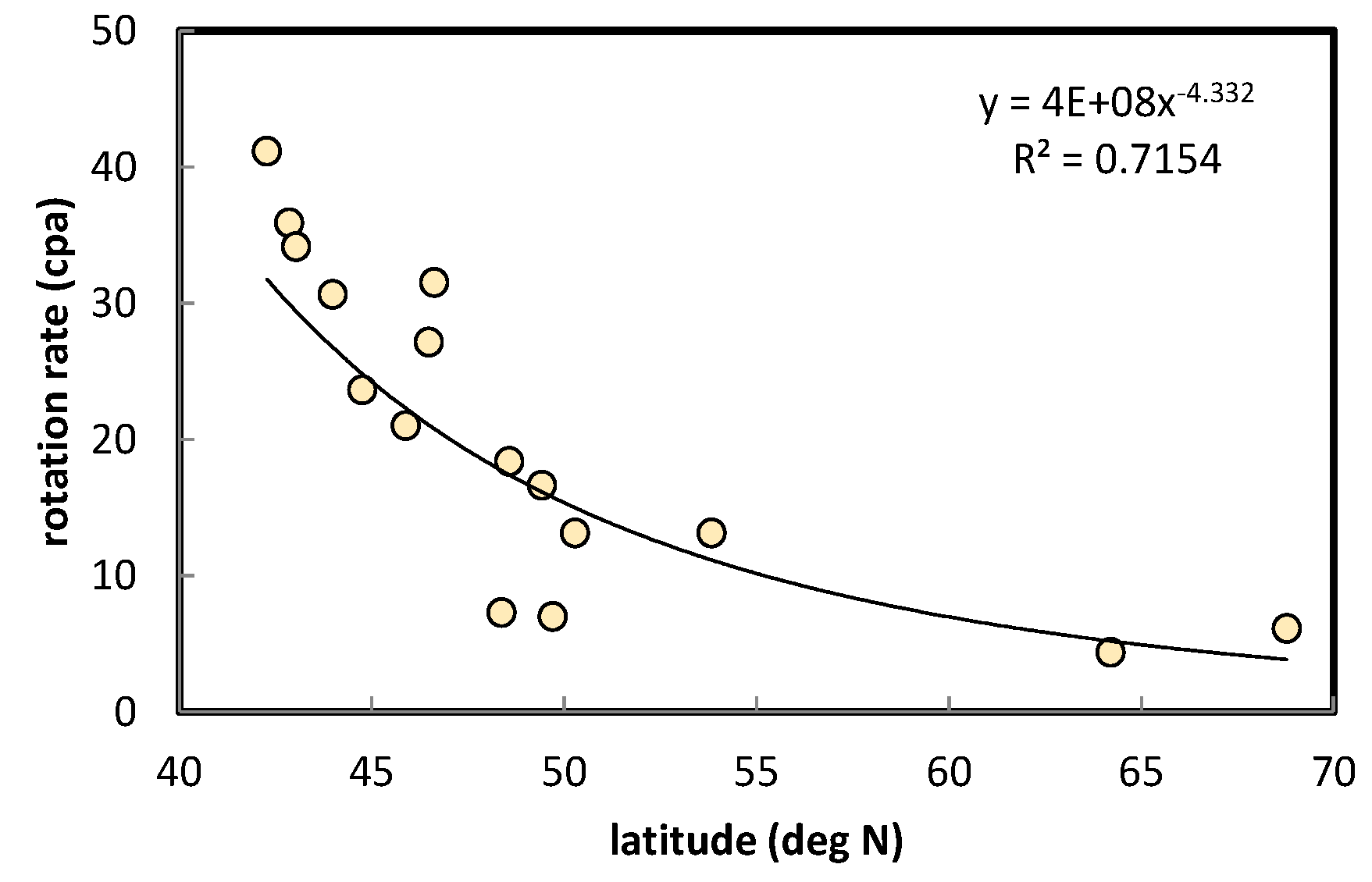
3.4. Identification of a “Core” Subset of Stations with Clear Latitudinal Dependence and Steadiness in SWR
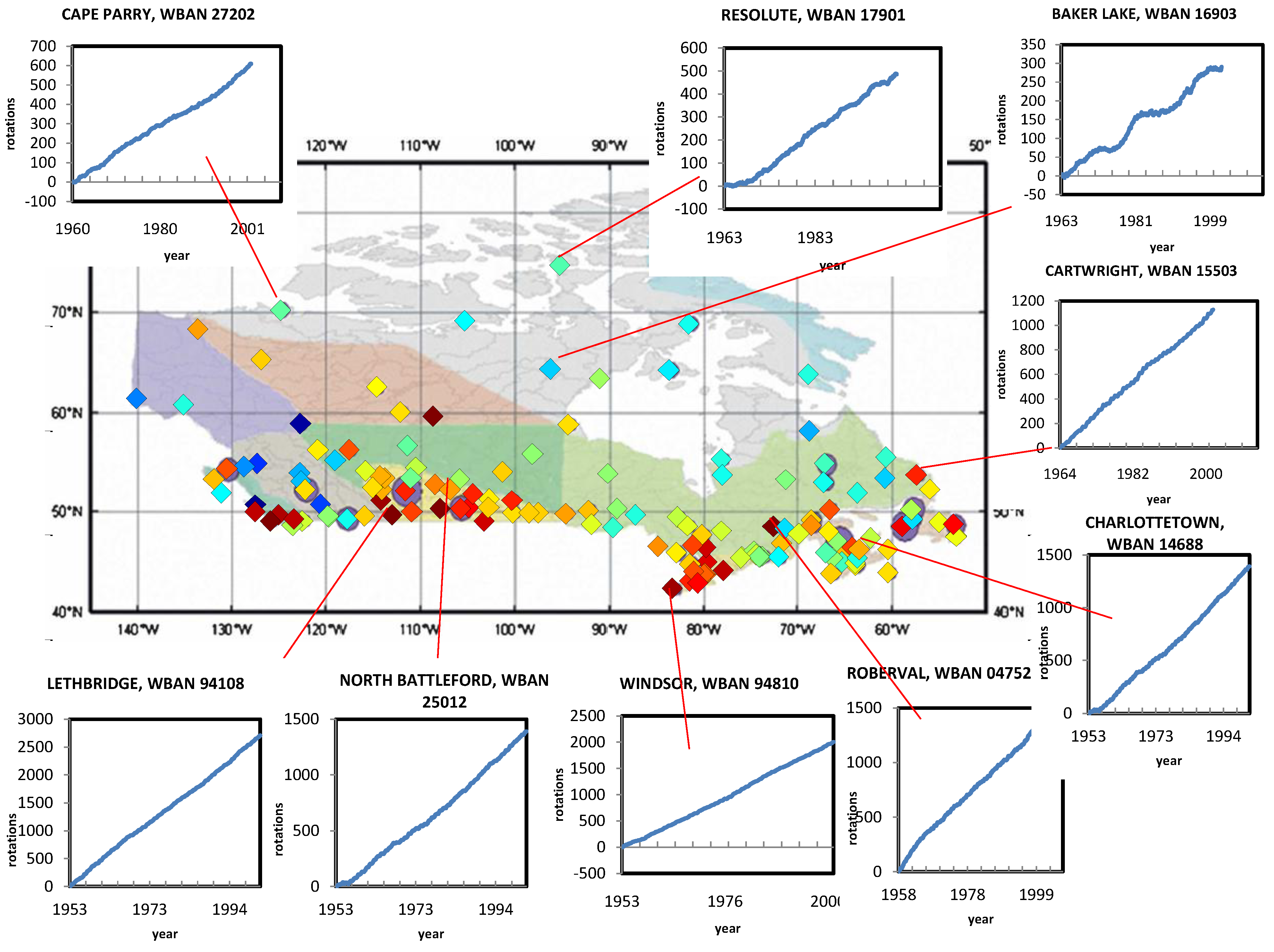
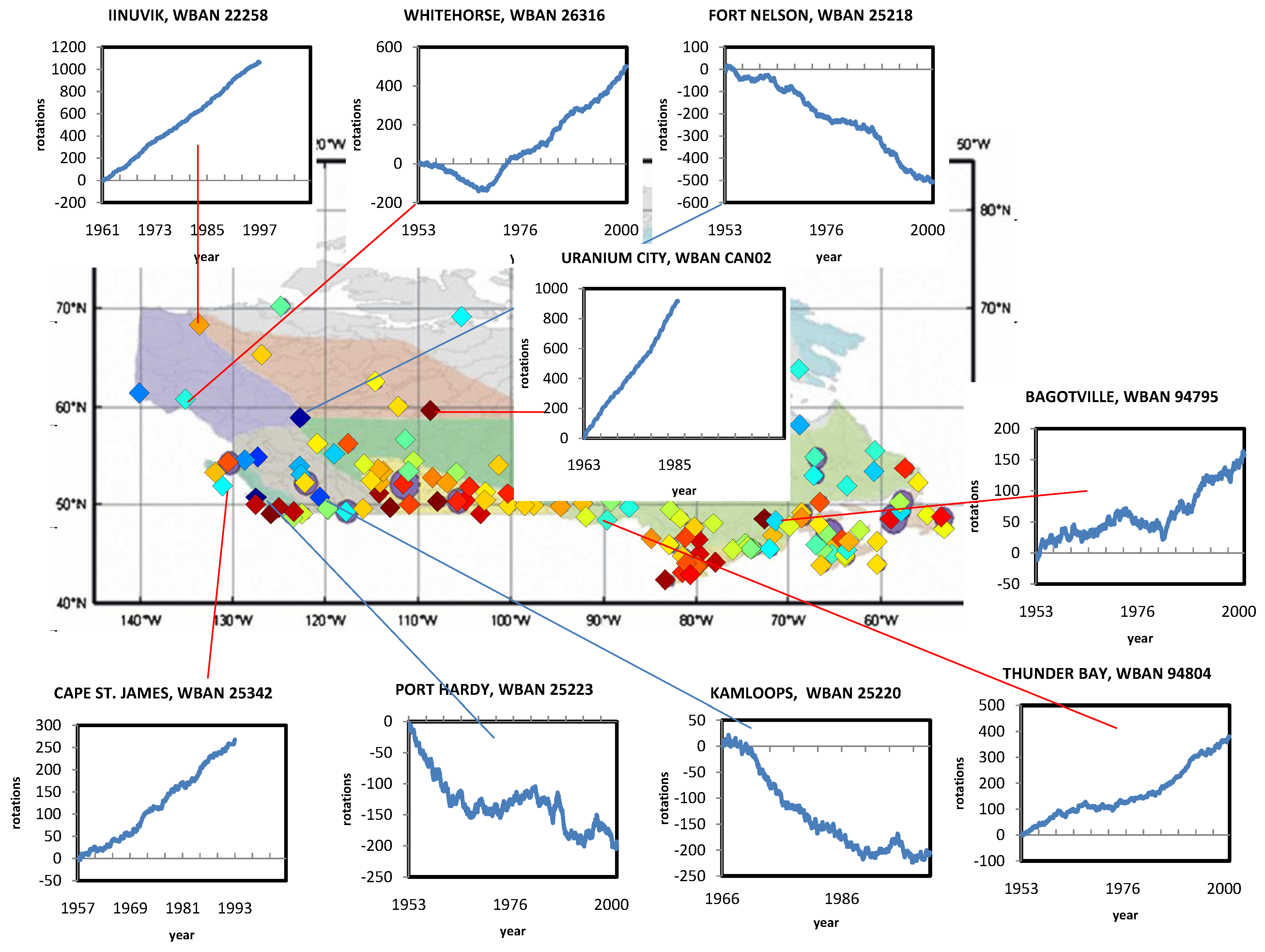
4. Discussion
5. Conclusions
- (1) The surface wind in most of Canada generally undergoes slow anticyclonic SWR, i.e., long-term, low-frequency periodicity beyond the synoptic scale, which represents a steady net imbalance of cyclonic and anticyclonic events (vortices).
- (2) The frequency of SWR was inversely correlated with latitude.
- (3) Of the meteostations analyzed, a small proportion (3%) exhibited negative (cyclonic) rotation in regions subject to the influence of the ocean and/or mountains.
- (4) The observed continental SWR appears to be deterministic, virtually ubiquitous, and highly persistent.
- (5) The role of orography and local meteorological forcings in SWR small-scale variability merits investigation.
Acknowledgements
References
- Mass, C.F.; Ovens, D.; Westrick, K.; Colle, B.A. Does increasing horizontal resolution produce more skillful forecasts? Bound. Lay. Meteorol. 2002, 83, 407–430. [Google Scholar]
- Horvath, K.; Koracin, D.; Vellore, R.; Jiang, J.; Belu, R. Sub-kilometer dynamical downscaling of near-surface winds in complex terrain using WRF and MM5 mesoscale models. J. Geophys. Res. 2012. [Google Scholar] [CrossRef]
- Stewart, J.Q.; Whiteman, C.D.; Steenburgh, W.J.; Bian, X. A climatological study of thermally driven wind systems of the US Intermountain West. Bull. Amer. Meteor. Soc. 2002, 83, 699–708. [Google Scholar] [CrossRef]
- Rife, D.L.; Davis, C.A.; Liu, Y.; Warner, T.T. Predictability of low-level winds by mesoscale meteorological models. Mon. Wea. Rev. 2004, 132, 2553–2569. [Google Scholar] [CrossRef]
- Seaman, N.L.; Gaudet, B.J.; Stauffer, D.R.; Mahrt, L.; Richardson, S.J.; Zielonka, J.R.; Wyngaard, J.C. Numerical prediction of submesoscale flow in the nocturnal stable boundary layer over complex terrain. Mon. Wea. Rev. 2012, 140, 956–977. [Google Scholar] [CrossRef]
- Bravo, M.; Mira, T.; Soler, M.R.; Cuxart, J. Intercomparison and evaluation of MM5 and Meso-NH mesoscale models in the stable boundary layer. Bound. Layer Meteorol. 2008, 128, 77–101. [Google Scholar] [CrossRef]
- Hamilton, K. General circulation model simulation of the structure and energetic of atmospheric models. Tellus 1987, 39A, 435–459. [Google Scholar] [CrossRef]
- Luo, Y.; Manson, A.H.; Meek, C.E.; Meyer, C.K.; Forbes, J.M. The quasi 16-day oscillations in the mesosphere and lower thermosphere at Saskatoon (52 N, 107 W), 1980-1996. J. Geophys. Res. 2000, 105, 2125–2138. [Google Scholar] [CrossRef]
- Luo, Y.; Hall, C.; Manson, A.H.; Meek, C.E.; Meyer, C.K.; Burrage, M.D.; Fritts, D.C.; Hocking, W.K.; MacDougall, J.; Riggin, D.M.; et al. The 16-day planetary waves: Multi-MF radar observations from the arctic to equator and comparisons with the HRDI measurements and the GSWM modelling results. Ann. Geophys. 2002, 20, 691–709. [Google Scholar] [CrossRef]
- Hodges, K.I.; Hoskins, B.J.; Boyle, J.; Thorncroft, C. A comparison of recent reanalysis datasets using objective feature tracking: Storm tracks and tropical easterly waves. Mon. Wea. Rev. 2003, 131, 2012–2037. [Google Scholar] [CrossRef]
- Wallace, J.M.; Lim, G.H.; Blackmon, M.L. Relationship between cyclone tracks, anticyclone tracks and baroclinic waveguides. J. Atmos. Sci. 1988, 45, 439–462. [Google Scholar] [CrossRef]
- Dell’Aquila, A.; Lucarini, V.; Ruti, P.M.; Calmanti, S. Hayashi spectra of the northern hemisphere mid-latitude atmospheric variability in the NCEP-NCAR and ECMWF reanalyses. Clim. Dynam. 2005, 25, 639–652. [Google Scholar] [CrossRef]
- Madden, R.A. Large-scale, free Rossby waves in the atmosphere-An update. Tellus 2007, 59A, 571–590. [Google Scholar]
- Chambers, F. The diurnal variations of the wind and barometric pressure at Bombay. Phil. Trans. R. Soc. 1873, 163, 1–18. [Google Scholar] [CrossRef]
- Haurwitz, B. Comments on the sea-breeze circulation. J. Meteor. 1947, 4, 1–8. [Google Scholar] [CrossRef]
- Neumann, J. On the rotation rate of the direction of sea and land breezes. J. Atmos. Sci. 1977, 34, 1913–1917. [Google Scholar] [CrossRef]
- Kusuda, M.; Alpert, P. Anticlockwise rotation of the wind hodograph. Part I: Theoretical study. J. Atmos. Sci. 1983, 40, 487–499. [Google Scholar] [CrossRef]
- Gille, S.T.; Llewellyn Smith, S.G.; Lee, S.M. Measuring the sea breeze from QuikSCAT scatterometry. Geophys. Res. Lett. 2003. [Google Scholar] [CrossRef]
- Kuo, A.C.; Polvani, L.M. Nonlinear geostrophic adjustment, cyclone/anticyclone asymmetry, and potential vorticity rearrangement. Phys. Fluids 2000, 12, 1087–1100. [Google Scholar] [CrossRef]
- Shipton, J. Balance, Gravity Waves and Jets in Turbulent Shallow Water Flows. Ph.D. Thesis, University of Sanit Andrews, Scotland, UK, 2009. [Google Scholar]
- Alpert, P.; Kusuda, M.; Abe, N. Anticlockwise rotation, eccentricity and tilt angle of the wind hodograph. Part II: An observational study. J. Atmos. Sci. 1984, 51, 3568–3583. [Google Scholar]
- Furberg, M.; Steyn, D.G.; Baldi, M. The climatology of sea breezes on Sardinia. Intl. J. Climatol. 2002, 22, 917–932. [Google Scholar]
- Sakazaki, T.; Fujiwara, M. Diurnal variations in summertime surface wind upon Japanese plains: Hodograph rotation and its dynamics. J. Meteor. Soc. Japan 2008, 86, 787–803. [Google Scholar] [CrossRef]
- Environment Canada. CWEEDS-Canadian Weather Energy and Engineering Data Set Files. Available online: ftp://arcdm20.tor.ec.gc.ca/pub/dist/climate/CWEEDS_2005/ (accessed on 23 November 2011).
- Fernandes, R.; Korolevych, V.; Wang, S. Trends in land evapotranspiration over Canada for the period 1960-2000 based on in situ climate observations and a land surface model. J. Hydrometeor. 2007, 8, 1016–1030. [Google Scholar] [CrossRef]
- Environment Canada. CDCD-Canadian Daily Climate Data 2 vols. Available online: ftp://arcdm20.tor.ec.gc.ca/pub/dist/CDCD/CDCD_DCQC_2007.zip (accessed on 23 November 2011).
- Mahrt, L. Surface wind direction variability. J. Appl. Meteor. Climatol. 2011, 50, 144–152. [Google Scholar] [CrossRef]
- Gonella, J. A rotary-component method for analysing meteorological and oceanographic vector time series. Deep-Sea Res. 1972, 19, 833–846. [Google Scholar]
- Emery, W.J.; Thomson, R.E. Data Analysis Methods in Physical Oceanography; Elsevier: Amsterdam, The Netherland, 2001; pp. 425–432. [Google Scholar]
- Theil, H. A rank-invariant method of linear and polynomial regression analysis. Indagationes. Math. 1950, 12, 85–91. [Google Scholar]
- Kendall, M.G. Rank Correlation Methods; Oxford University Press: Oxford, UK, 1975; p. 202. [Google Scholar]
- Hirsch, R.M.; Helsel, D.R.; Cohn, T.A.; Gilroy, E.J. Statistical Analysis of Hydrologic Data. In Handbook of Hydrology; McGraw-Hill: New York, NY, USA, 1993; p. 17. [Google Scholar]
© 2012 by the authors; licensee MDPI, Basel, Switzerland. This article is an open-access article distributed under the terms and conditions of the Creative Commons Attribution license (http://creativecommons.org/licenses/by/3.0/).
Share and Cite
Korolevych, V.Y.; Richardson, R.B. Low-Frequency Rotation of Surface Winds over Canada. Atmosphere 2012, 3, 522-536. https://doi.org/10.3390/atmos3040522
Korolevych VY, Richardson RB. Low-Frequency Rotation of Surface Winds over Canada. Atmosphere. 2012; 3(4):522-536. https://doi.org/10.3390/atmos3040522
Chicago/Turabian StyleKorolevych, Vladimir Y., and Richard B. Richardson. 2012. "Low-Frequency Rotation of Surface Winds over Canada" Atmosphere 3, no. 4: 522-536. https://doi.org/10.3390/atmos3040522




